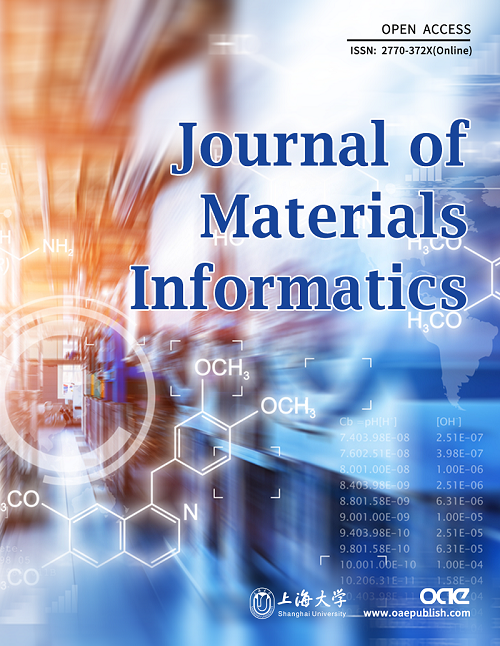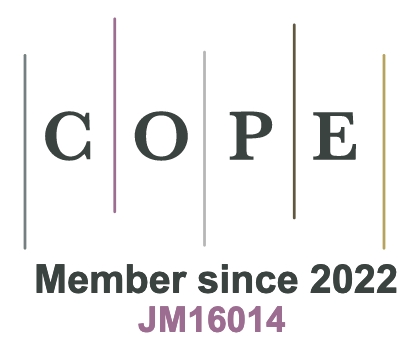REFERENCES
1. Yaghi OM, O’Keeffe M, Ockwig NW, Chae HK, Eddaoudi M, Kim J. Reticular synthesis and the design of new materials. Nature 2003;423:705-14.
2. Bubeck S, Chandrasekaran V, Eldan R, et al. Sparks of artificial general intelligence: early experiments with GPT-4. ArXiv. [Preprint] Apr 13, 2023. [accessed on 2024 Jun 14]. Available from: https://doi.org/10.48550/arXiv.2303.12712.
3. Li Y, Wu Y, Han Y, et al. Local environment interaction-based machine learning framework for predicting molecular adsorption energy. J Mater Inf 2024;4:4.
4. Yang Y, Xu B, Zong H. Physics infused machine learning force fields for 2D materials monolayers. J Mater Inf 2023;3:23.
5. Wang Y, Xie T, France-lanord A, et al. Toward designing highly conductive polymer electrolytes by machine learning assisted coarse-grained molecular dynamics. Chem Mater 2020;32:4144-51.
6. Xie T, France-Lanord A, Wang Y, et al. Accelerating amorphous polymer electrolyte screening by learning to reduce errors in molecular dynamics simulated properties. Nat Commun 2022;13:3415.
7. Luo H, Chen S, Liu L, et al. Core–shell nanostructure design in polymer nanocomposite capacitors for energy storage applications. ACS Sustain Chem Eng 2019;7:3145-53.
8. Hu H, Zhang F, Luo S, Chang W, Yue J, Wang C. Recent advances in rational design of polymer nanocomposite dielectrics for energy storage. Nano Energy 2020;74:104844.
9. St John PC, Phillips C, Kemper TW, et al. Message-passing neural networks for high-throughput polymer screening. J Chem Phys 2019;150:234111.
10. Munshi J, Chen W, Chien T, Balasubramanian G. Transfer learned designer polymers for organic solar cells. J Chem Inf Model 2021;61:134-42.
11. Bai Y, Wilbraham L, Slater BJ, Zwijnenburg MA, Sprick RS, Cooper AI. Accelerated discovery of organic polymer photocatalysts for hydrogen evolution from water through the integration of experiment and theory. J Am Chem Soc 2019;141:9063-71.
12. Liang J, Xu S, Hu L, Zhao Y, Zhu X. Machine-learning-assisted low dielectric constant polymer discovery. Mater Chem Front 2021;5:3823-9.
13. Rajendran S, Palani G, Kanakaraj A, et al. Metal and polymer based composites manufactured using additive manufacturing - a brief review. Polymers 2023;15:2564.
14. Oladele IO, Omotosho TF, Adediran AA, Beatriz Morales-cepeda A. Polymer-based composites: an indispensable material for present and future applications. Int J Polym Sci 2020;2020:8834518.
15. Wang L, Yang C, Wang X, et al. Advances in polymers and composite dielectrics for thermal transport and high-temperature applications. Compos Part A Appl S 2023;164:107320.
16. Jayalath S, Herath M, Epaarachchi J, Trifoni E, Gdoutos EE, Fang L. Durability and long-term behaviour of shape memory polymers and composites for the space industry - a review of current status and future perspectives. Polym Degrad Stabil 2023;211:110297.
17. Gouzman I, Grossman E, Verker R, Atar N, Bolker A, Eliaz N. Advances in polyimide-based materials for space applications. Adv Mater 2019;31:e1807738.
19. Liaw D, Wang K, Huang Y, Lee K, Lai J, Ha C. Advanced polyimide materials: syntheses, physical properties and applications. Prog Polym Sci 2012;37:907-74.
20. Li Y, Sun G, Zhou Y, Liu G, Wang J, Han S. Progress in low dielectric polyimide film - a review. Prog Org Coat 2022;172:107103.
21. Song N, Yao H, Ma T, et al. Decreasing the dielectric constant and water uptake by introducing hydrophobic cross-linked networks into co-polyimide films. Appl Surf Sci 2019;480:990-7.
22. Song N, Shi K, Yu H, et al. Decreasing the dielectric constant and water uptake of co-polyimide films by introducing hydrophobic cross-linked networks. Eur Polym J 2018;101:105-12.
23. Liu TQ, Zheng F, Ma X, et al. High heat-resistant polyimide films containing quinoxaline moiety for flexible substrate applications. Polymer 2020;209:122963.
24. Liu B, Zhou Y, Dong L, Lu Q, Xu X. Enhanced thermal conductivity in copolymerized polyimide. iScience 2022;25:105451.
25. Lian R, Lei X, Xiao Y, et al. Synthesis and properties of colorless copolyimides derived from 4,4’-diaminodiphenyl ether-based diamines with different substituents. Polym Chem 2021;12:4803-11.
26. Jiao L, Du Z, Dai X, Wang H, Yao H, Qiu X. Multifunctional polyimide films with superheat-resistance, low coefficient of thermal expansion and fluorescence performance. Polymer 2022;247:124792.
27. Hicyilmaz A, Celik Bedeloglu A. Applications of polyimide coatings: a review. SN Appl Sci 2021;3:363.
29. Tao L, He J, Munyaneza NE, et al. Discovery of multi-functional polyimides through high-throughput screening using explainable machine learning. Chem Eng J 2023;465:142949.
30. Batra R, Song L, Ramprasad R. Emerging materials intelligence ecosystems propelled by machine learning. Nat Rev Mater 2021;6:655-78.
31. Chen L, Pilania G, Batra R, et al. Polymer informatics: current status and critical next steps. Mat Sci Eng R 2021;144:100595.
32. Kuenneth C, Ramprasad R. polyBERT: a chemical language model to enable fully machine-driven ultrafast polymer informatics. Nat Commun 2023;14:4099.
33. Chen G, Shen Z, Iyer A, et al. Machine-learning-assisted de novo design of organic molecules and polymers: opportunities and challenges. Polymers 2020;12:163.
34. Choi J, Yu S, Yang S, Cho M. The glass transition and thermoelastic behavior of epoxy-based nanocomposites: a molecular dynamics study. Polymer 2011;52:5197-203.
35. Huang X, Ju S. Tutorial: AI-assisted exploration and active design of polymers with high intrinsic thermal conductivity. J Appl Phys 2024;135:171101.
36. Tao L, Chen G, Li Y. Machine learning discovery of high-temperature polymers. Patterns 2021;2:100225.
37. Uddin MJ, Fan J. Interpretable machine learning framework to predict the glass transition temperature of polymers. Polymers 2024;16:1049.
38. Katritzky AR, Kuanar M, Slavov S, et al. Quantitative correlation of physical and chemical properties with chemical structure: utility for prediction. Chem Rev 2010;110:5714-89.
39. Mannodi-kanakkithodi A, Chandrasekaran A, Kim C, et al. Scoping the polymer genome: a roadmap for rational polymer dielectrics design and beyond. Mater Today 2018;21:785-96.
40. Volgin IV, Batyr PA, Matseevich AV, et al. Machine learning with enormous “synthetic” data sets: predicting glass transition temperature of polyimides using graph convolutional neural networks. ACS Omega 2022;7:43678-91.
41. Zhang S, He X, Xia X, et al. Machine-learning-enabled framework in engineering plastics discovery: a case study of designing polyimides with desired glass-transition temperature. ACS Appl Mater Interfaces 2023;15:37893-902.
42. Huang X, Ma S, Zhao CY, Wang H, Ju S. Exploring high thermal conductivity polymers via interpretable machine learning with physical descriptors. npj Comput Mater 2023;9:191.
43. Honda S, Shi S, Ueda HR. SMILES Transformer: Pre-trained molecular fingerprint for low data drug discovery. ArXiv. [Preprint] Nov 12, 2019. [accessed on 2024 Jun 14]. Available from: https://arxiv.org/abs/1911.04738.
44. Ying C, Cai T, Luo S, et al. Do transformers really perform bad for graph representation? ArXiv. [Preprint] Nov 24, 2021. [accessed on 2024 Jun 14]. Available from: https://arxiv.org/abs/2106.05234.
45. Irwin R, Dimitriadis S, He J, Bjerrum EJ. Chemformer: a pre-trained transformer for computational chemistry. Mach Learn Sci Technol 2022;3:015022.
46. Barredo Arrieta A, Díaz-rodríguez N, Del Ser J, et al. Explainable artificial intelligence (XAI): concepts, taxonomies, opportunities and challenges toward responsible AI. Inform Fusion 2020;58:82-115.
47. Wen C, Wang C, Zhang Y, et al. Modeling solid solution strengthening in high entropy alloys using machine learning. Acta Mater 2021;212:116917.
48. Zhang S, Du S, Wang L, et al. Design of silicon-containing arylacetylene resins aided by machine learning enhanced materials genome approach. Chem Eng J 2022;448:137643.
49. Xu C, Wang Y, Barati Farimani A. TransPolymer: a transformer-based language model for polymer property predictions. npj Comput Mater 2023;9:64.
50. Vermeire FH, Green WH. Transfer learning for solvation free energies: from quantum chemistry to experiments. Chem Eng J 2021;418:129307.
51. Panapitiya G, Girard M, Hollas A, et al. Evaluation of deep learning architectures for aqueous solubility prediction. ACS Omega 2022;7:15695-710.
52. Zhang D, Xia S, Zhang Y. Accurate prediction of aqueous free solvation energies using 3D atomic feature-based graph neural network with transfer learning. J Chem Inf Model 2022;62:1840-8.
53. Chen C, Ye W, Zuo Y, Zheng C, Ong SP. Graph networks as a universal machine learning framework for molecules and crystals. Chem Mater 2019;31:3564-72.
54. Wu S, Kondo Y, Kakimoto M, et al. Machine-learning-assisted discovery of polymers with high thermal conductivity using a molecular design algorithm. npj Comput Mater 2019;5:66.
55. Qiao W. Synthesis and properties of polyimides derived from m-xylylenediamine monomer. Fine Chem 2022;39:1141-7. (in Chinese) Available from: http://www.finechemicals.com.cn/jxhg/article/abstract/202111181175?st=search. [Last accessed on 14 Jun 2024]
56. Yang Z, Kang C, Guo H, Gao L. Synthesis and properties of polyimide films for flexible OLED displays. Acta Polym Sin 2021;52:1308-15.
57. Wang T, Su YM, Chen F, Li WM. Synthesis and characterization of polyimides based on twisted non-coplanar backbone containing indolocarbazole. Chin J Struc Chem 2021;40:1611-20.
58. Luo JR, Liu YD, Liu H, et al. Synthesis and characterization of polyimides with naphthalene ring structure introduced in the main chain. Materials 2022;15:8014.
59. Li Q, Zhang S, Liao G, Yi C, Xu Z. Novel fluorinated hyperbranched polyimides with excellent thermal stability, UV-shielding property, organosolubility, and low dielectric constants. High Perform Polym 2018;30:872-86.
60. Liu Z, Shen Y, Li X, Shi Q, Liu B, Matsumoto T. Synthesis and properties of the novel polyimides containing cyano and biphenyl moieties. High Perform Polym 2018;30:1183-92.
61. Yu B, Jiang C, Wang C. Synthesis and characterization of highly transparent fluorinated copolymer polyimide. Fine Chem 2019;36. (in Chinese) Available from: http://www.finechemicals.com.cn/jxhg/article/abstract/201904030272?st=search. [Last accessed on 14 Jun 2024]
62. Liu Y, Zhou L, Sheng S, Song C, Hou H, Song C. Synthesis and properties of super-high temperature diketone anhydride polyimides. Chin J Appl Chem 2019;36:658-63.
63. Cui X, Yang J. Synthesis and characterization of high performance thermoplastic polyimide used the anti-riot bomb. In: International Conference on Electronical, Mechanical and Materials Engineering (ICE2ME); Wuhan, China; 2019. pp. 207-10.
64. Abdulhamid MA, Ma X, Ghanem BS, Pinnau I. Synthesis and characterization of organo-soluble polyimides derived from alicyclic dianhydrides and a dihydroxyl-functionalized spirobisindane diamine. ACS Appl Polym Mater 2019;1:63-9.
65. Zhang H, Wang W, Chen G, Zhang A, Fang X. Melt-processable semicrystalline polyimides based on 1,4-bis(3,4-dicarboxyphenoxy)benzene dianhydride (HQDPA): synthesis, crystallization, and melting behavior. Polymers 2017;9:420.
66. Liu Y, Huang J, Tan J, et al. Synthesis and characterization of intrinsic high-barrier polyimide derived from a novel diamine monomer containing rigid planar moiety. J Polym Sci Part A Polym Chem 2017;55:2373-82.
67. Wang C, Zhao X, Tian D, Wang D, Chen C, Zhou H. Synthesis and characterization of novel polyimides derived from 4,4’-bis(5-amino-2-pyridinoxy)benzophenone: effect of pyridine and ketone units in the main. Des Monomers Polym 2017;20:97-105.
68. Wu F, Zhou X, Yu X. Synthesis and characterization of novel star-branched polyimides derived from 2,2-bis[4-(2,4-diaminophenoxy)phenyl]hexafluoropropane. RSC Adv 2017;7:35786-94.
69. Lei Y, Shu Y, Peng J, Tang Y, Huo J. Synthesis and properties of low coefficient of thermal expansion copolyimides derived from biphenyltetracarboxylic dianhydride with p-phenylenediamine and 4,4’-oxydialinine. e Polymers 2016;16:295-302.
70. Huang X, Pei X, Wang L, Mei M, Liu C, Wei C. Design and synthesis of organosoluble and transparent polyimides containing bulky substituents and noncoplanar structures. J Appl Polym Sci 2016;133:app.43266.
71. Li B, Yan Z, Zhang T, et al. Synthesis and properties of novel colorless and thermostable polyimides containing cross-linkable bulky tetrafluorostyrol pendant group and organosoluble triphenylmethane backbone structure. J Polym Sci 2020;58:2355-65.
72. Yuan C, Sun Z, Wang Y. Synthesis and characterization of a novel organo-soluble polyimide containing hydroxyl and bis-tert-butyl substituted triphenylpyridine units. J Polym Res 2020;27:220.
73. Mirsamiei A. Synthesis and properties of polyimides derived from bis-(Aminophenoxy) containing naphthalene, [Phenyl] propane and [Methyl] cyclohexane segment and 4, 4’-carbonyldiphthalic anhydride. J Macromol Sci A 2018;55:519-25.
74. Wang Z, Guo L, Han S, Qi H, Cheng Y, Liu F. Polyimides from an asymmetric hydroxyl-containing aliphatic-aromatic diamine synthesized via henry reaction. J Polym Sci Part A Polym Chem 2017;55:3413-23.
75. Zhao H, Chen G, Zhou Y, Li X, Fang X. Synthesis and characterization of organosoluble and transparent polyimides derived from trans-1,2-bis(3,4-dicarboxyphenoxy)cyclohexane dianhydride. J Appl Polym Sci 2015;132:app.42317.
76. Liu C, Mei M, Pei X, Huang X, Wei C. Aromatic polyimides with tertbutyl-substituted and pendent naphthalene units: synthesis and soluble, transparent properties. Chin J Polym Sci 2015;33:1074-85.
77. Li Q, Xiong H, Pang L, et al. Synthesis and characterization of thermally stable, hydrophobic hyperbranched polyimides derived from a novel triamine. High Perform Polym 2015;27:426-38.
78. Chen Y, Zhang Q. Synthesis, characterization and properties of aromatic copolyimides containing Bi-benzimidazole moiety. J Polym Res 2015;22:78.
79. Guan Y, Wang C, Wang D, et al. High transparent polyimides containing pyridine and biphenyl units: synthesis, thermal, mechanical, crystal and optical properties. Polymer 2015;62:1-10.
80. Wang Y, Wang N, Yu Z, Li G, Zhang X. Novel dye-containing copolyimides: synthesis, characterization and effect of chain entanglements on developed electrospun nanofiber morphologies. J Polym Res 2015;22:65.
81. Tapaswi PK, Choi M, Nagappan S, Ha C. Synthesis and characterization of highly transparent and hydrophobic fluorinated polyimides derived from perfluorodecylthio substituted diamine monomers. J Polym Sci Part A Polym Chem 2015;53:479-88.
82. Aguilar-lugo C, Santiago-garcía JL, Loría-bastarrachea MI, Guzmán-lucero D, Alexandrova L, Aguilar-vega M. Synthesis, characterization, and structure-property relationships of aromatic polyimides containing 4,4’-diaminotriphenylmethane. J Polym Res 2016;23:49.
83. Kumar A, Tateyama S, Yasaki K, et al. Ultrahigh performance bio-based polyimides from 4,4’-diaminostilbene. Polymer 2016;83:182-9.
84. Liu S, Zhang Y, Wang X, Tan H, Song N, Guan S. Synthesis and properties of hyperbranched polyimides derived from tetra-amine and long-chain aromatic dianhydrides. RSC Adv 2015;5:107793-803.
85. Yang G, Zhang R, Huang H, Liu L, Wang L, Chen Y. Synthesis of novel biobased polyimides derived from isomannide with good optical transparency, solubility and thermal stability. RSC Adv 2015;5:67574-82.
86. Zhou Y, Chen G, Zhao H, Song L, Fang X. Synthesis and properties of transparent polyimides derived from trans-1,4-bis(2,3-dicarboxyphenoxy)cyclohexane dianhydride. RSC Adv 2015;5:53926-34.
87. Wang Y. Synthesis and characterization of novel polyimides derived from 2,4-bis(4-aminophenoxy)pyrimidine. High Perform Polym 2014;26:978-85.
88. Tapaswi PK, Choi M, Jung YS, Cho HJ, Seo DJ, Ha C. Synthesis and characterization of fully aliphatic polyimides from an aliphatic dianhydride with piperazine spacer for enhanced solubility, transparency, and low dielectric constant. J Polym Sci Part A Polym Chem 2014;52:2316-28.
89. Li Y, Liu C, Jiao L, Song G, Zhao X, Dang G. Synthesis of new autophotosensitive semiaromatic hyperbranched polyimides with excellent mechanical properties and low birefringences. High Perform Polym 2014;26:569-77.
90. Guan Y, Wang D, Song G, et al. Synthesis and characterization of novel polyimides derived from 3,6-bis(4-aminophenoxy)pyridazine. High Perform Polym 2014;26:455-62.
91. Cao X, Song Y, Matsumoto T, Liu B. Synthesis and properties of cyano group-containing polyimides with high peel strength. High Perform Polym 2016;28:953-61.
92. Chen Y, Zhang Q. Synthesis and properties of polyimides derived from diamine monomer containing bi-benzimidazole unit. J Polym Res 2014;21:424.
93. Yao H, Zhang Y, Liu Y, et al. Synthesis and properties of cross-linkable high molecular weight fluorinated copolyimides. J Polym Sci Part A Polym Chem 2014;52:349-59.
94. Chen Y, Zhang Q, Sun W, Lei X, Yao P. Synthesis and gas permeation properties of hyperbranched polyimides membranes from a novel (A2+B2B’+B2)-type method. J Membr Sci 2014;450:138-46.
95. Guan Y, Wang D, Wang Z, et al. Synthesis and characterization of novel polyimides from 4,4’-bis(5-amino-2-pyridinoxy)diphenyl ether, 4,4’-bis(5-amino-2-pyridinoxy)diphenyl thioether and 4,4’-bis(5-amino-2-pyridinoxy)diphenyl sulfone. RSC Adv 2014;4:50163-70.
96. Liu C, Pei X, Mei M, Chou G, Huang X, Wei C. Synthesis and characterization of organosoluble, transparent, and hydrophobic fluorinated polyimides derived from 3,3’-diisopropyl-4,4’-diaminodiphenyl-4’’-trifluoromethyltoluene. High Perform Polym 2016;28:1114-23.
97. Ding M. Polyimides: chemistry, structure-property relationships and materials. 2nd editon. 2012. (in Chinese) Available from: https://www.ecsponline.com/yz/B405754A7A8064FF096F194B3B878E2BD000.pdf. [Last accessed on 14 Jun 2024]
98. Huang X, Zhao C, Wang H, Ju S. AI-assisted inverse design of sequence-ordered high intrinsic thermal conductivity polymers. Mater Today Phys 2024;44:101438.
99. Persson P, Bergström R, Lunell S. Quantum chemical study of photoinjection processes in dye-sensitized TiO2 nanoparticles. J Phys Chem B 2000;104:10348-51.
100. Nakajima T, Sawada K. Discovery of Pb-free perovskite solar cells via high-throughput simulation on the K computer. J Phys Chem Lett 2017;8:4826-31.
101. Zhang Y, Zheng Z, Chen F, Li M, Ding P, Lu W. Accelerating the discovery of N-annulated perylene organic sensitizers via an interpretable machine learning model. J Mol Struc 2024;1296:136855.
102. Butler KT, Davies DW, Cartwright H, Isayev O, Walsh A. Machine learning for molecular and materials science. Nature 2018;559:547-55.
103. Chen Y, Liu Y, Min Y. Synthesis and properties comparison of low dielectric silicon containing polyimides. Materials 2022;15:2755.
104. Zhang W, Hu Z, Lu Y, et al. Molecular dynamics simulation on the heat transfer in the cross-linked poly(dimethylsiloxane). J Phys Chem B 2023;127:10243-51.
105. Le NL, Wang Y, Chung T. Synthesis, cross-linking modifications of 6FDA-NDA/DABA polyimide membranes for ethanol dehydration via pervaporation. J Membr Sci 2012;415-6:109-21.








